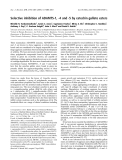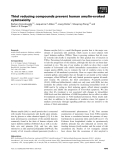
Compounds in response
-
A cytosolic thyroid-hormone-binding protein (xCTBP), predominantly responsible for the major binding activity of T3 in the cytosol of Xenopus liver, has been shown to be identical to aldehyde dehydrogenase class 1 (ALDH1) [Yamauchi, K., Nakajima, J., Hayashi, H., Horiuchi, R. & Tata, J.R. (1999) J. Biol. Chem. 274, 8460–8469]. Within this paper we surveyed which signaling, and other, compounds affect the thyroid hormone binding activity and aldehyde dehydrogenase activity of recombinant Xenopus ALDH1 (xCTBP/xALDH1) while examining the relationship between these two activities....
 8p
8p  research12
research12
 01-06-2013
01-06-2013
 38
38
 4
4
 Download
Download
-
Three mammalian ADAMTS enzymes, ADAMTS-1, -4 and -5, are known to cleave aggrecan at certain glutamyl bonds and are considered to be largely responsible for car-tilage aggrecan catabolismobservedduring the development of arthritis. We have previously reported that certain cate-chins, polyphenolic compounds found in highest concen-trationingreentea(Camellia sinensis), are capable of inhibiting cartilage aggrecan breakdown in anin vitromodel of cartilage degradation.
 10p
10p  fptmusic
fptmusic
 16-04-2013
16-04-2013
 30
30
 3
3
 Download
Download
-
Spontaneous oxidation of 3-hydroxykynureine (3-HK), a metabolic inter-mediate of the tryptophan degradation pathway, elicits a remarkable oxida-tive stress response in animal tissues. In the yellow fever mosquito Aedes aegyptithe excess of this toxic metabolic intermediate is efficiently removed by a specific 3-HK transaminase, which converts 3-HK into the more sta-ble compound xanthurenic acid.
 10p
10p  fptmusic
fptmusic
 12-04-2013
12-04-2013
 39
39
 3
3
 Download
Download
-
Human amylin (hA) is a small fibrillogenic protein that is the major con-stituent of pancreatic islet amyloid, which occurs in most subjects with type-2 diabetes mellitus (T2Dm). There is growing evidence that hA toxic-ity towards islet b-cells is responsible for their gradual loss of function in T2Dm. Preventing hA-mediated cytotoxicity has been proposed as a route to halt the progression of this disease, although this has not yet been dem-onstratedin vivo.
 11p
11p  fptmusic
fptmusic
 12-04-2013
12-04-2013
 30
30
 1
1
 Download
Download
-
2-Amino-5-carboxymuconic 6-semialdehyde is an unstable intermediate in the meta-cleavage pathway of 4-amino-3-hydroxybenzoic acid inBordetellasp. strain 10d.In vitro, this compound is nonenzymatically converted to 2,5-pyrid-inedicarboxylic acid. Crude extracts of strain 10d grown on 4-amino-3-hydroxybenzoic acid converted 2-amino-5-car-boxymuconic 6-semialdehyde formed from 4-amino-3-hydroxybenzoic acid by the first enzyme in the pathway, 4-amino-3-hydroxybenzoate 2,3-dioxygenase, to a yellow compound (emax¼375 nm).
 0p
0p  awards
awards
 05-04-2013
05-04-2013
 45
45
 2
2
 Download
Download
-
Inflammation is traditionally viewed as a physiological reaction to tissue injury. Leukocytes contribute to the inflammatory response by the secretion of cytotoxic and pro-inflammatory compounds, by phagocytotic activity and by targeted attack of foreign antigens. Leukocyte accumulation in tis-sues is important for the initial response to injury.
 9p
9p  inspiron33
inspiron33
 25-03-2013
25-03-2013
 41
41
 4
4
 Download
Download
-
In vascular smooth muscle cells and several other cell types, inhibition of Na + ⁄K + -ATPase leads to the expression of early response genes, including c-Fos. We designed this study to examine whether or not a putative Na + i ⁄K + i-sensitive element is located within the c-Fos5¢-UTR from )650 to +103 containing all known response elements activated by ‘classic’ stimuli, such as growth factors and Ca 2+ i-raising compounds.
 11p
11p  galaxyss3
galaxyss3
 19-03-2013
19-03-2013
 35
35
 3
3
 Download
Download
-
The intracellular accumulation of low molecular mass organic compounds in response to stressful conditions was investigated in the thermophilic bacterium Petrotoga miotherma, a member of the order Thermotogales. This led to the discovery of a new solute, whose structure was established as a-d-mannopyranosyl-(1fi2)-a-d-glucopyranosyl-(1 fi2)-glycerate (MGG) by MMR spectroscopy and MS.
 8p
8p  galaxyss3
galaxyss3
 19-03-2013
19-03-2013
 25
25
 4
4
 Download
Download
-
The charged quaternary ammonium compounds – methyl, ethyl and benzyl viologens – generate reactive oxygen species in photosynthetic cells. Three independent methyl viologen-resistant spontaneous mutants of Synechocys-tis sp. PCC 6803 were identified, in which the conserved R115 residue of the Slr1174 protein was replaced with G115, L115 and C115. The Slr1174 protein of the DUF990 family is related to the permease subunit of an ABC-2-type transporter and its R115 mutation was found to be solely responsible for the observed methyl viologen resistance. ...
 11p
11p  vinaphone15
vinaphone15
 25-02-2013
25-02-2013
 30
30
 2
2
 Download
Download
CHỦ ĐỀ BẠN MUỐN TÌM














![Báo cáo khoa học: [Na+]i-induced c-Fos expression is not mediated by activation of the 5¢-promoter containing known transcriptional elements Báo cáo khoa học: [Na+]i-induced c-Fos expression is not mediated by activation of the 5¢-promoter containing known transcriptional elements](https://tailieu.vn/image/document/thumbnail/2013/20130319/galaxyss3/135x160/8161363693709.jpg)






